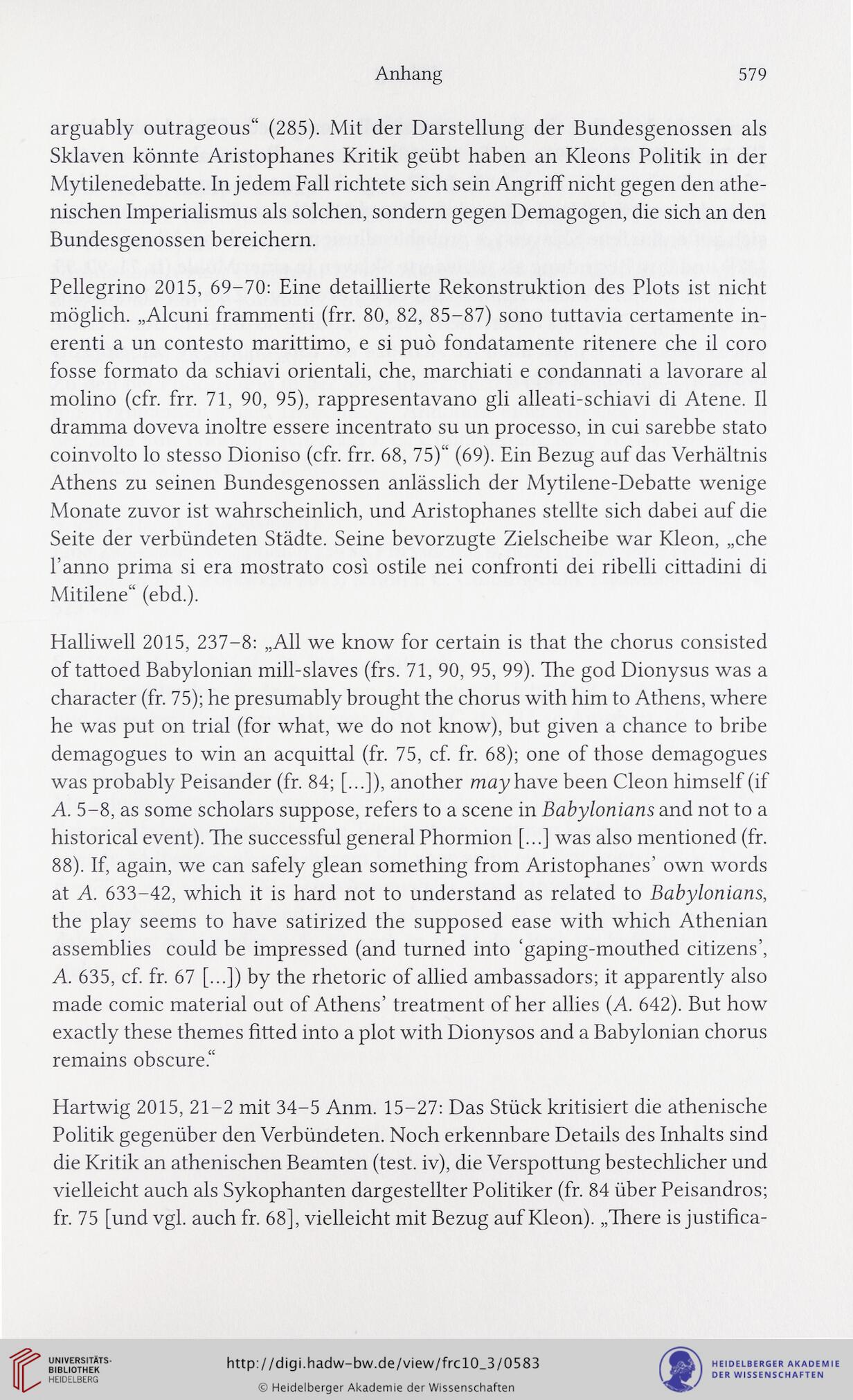Anhang
579
arguably outrageous“ (285). Mit der Darstellung der Bundesgenossen als
Sklaven könnte Aristophanes Kritik geübt haben an Kleons Politik in der
Mytilenedebatte. In jedem Fall richtete sich sein Angriff nicht gegen den athe-
nischen Imperialismus als solchen, sondern gegen Demagogen, die sich an den
Bundesgenossen bereichern.
Pellegrino 2015, 69-70: Eine detaillierte Rekonstruktion des Plots ist nicht
möglich. „Alcuni frammenti (frr. 80, 82, 85-87) sono tuttavia certamente in-
erenti a un contesto marittimo, e si puo fondatamente ritenere ehe il coro
fosse formato da schiavi orientali, ehe, marchiati e condannati a lavorare al
molino (cfr. frr. 71, 90, 95), rappresentavano gli alleati-schiavi di Atene. II
dramma doveva inoltre essere incentrato su un processo, in cui sarebbe stato
coinvolto lo stesso Dioniso (cfr. frr. 68, 75)“ (69). Ein Bezug auf das Verhältnis
Athens zu seinen Bundesgenossen anlässlich der Mytilene-Debatte wenige
Monate zuvor ist wahrscheinlich, und Aristophanes stellte sich dabei auf die
Seite der verbündeten Städte. Seine bevorzugte Zielscheibe war Kleon, „ehe
l’anno prima si era mostrato cosi ostile nei confronti dei ribelli cittadini di
Mitilene“ (ebd.).
Halliwell 2015, 237-8: „All we know for certain is that the chorus consisted
of tattoed Babylonian mill-slaves (frs. 71, 90, 95, 99). The god Dionysus was a
character (fr. 75); he presumably brought the chorus with him to Athens, where
he was put on trial (for what, we do not know), but given a chance to bribe
demagogues to win an acquittal (fr. 75, cf. fr. 68); one of those demagogues
was probably Peisander (fr. 84; [...]), another may have been Cleon himself (if
A. 5-8, as some scholars suppose, refers to a scene in Babylonians and not to a
historical event). The successful general Phormion [...] was also mentioned (fr.
88). If, again, we can safely glean something from Aristophanes’ own words
at A. 633-42, which it is hard not to understand as related to Babylonians,
the play seems to have satirized the supposed ease with which Athenian
assemblies could be impressed (and turned into ‘gaping-mouthed citizens’,
A. 635, cf. fr. 67 [...]) by the rhetoric of allied ambassadors; it apparently also
made comic material out of Athens’ treatment of her allies (A. 642). But how
exaetly these themes fitted into a plot with Dionysos and a Babylonian chorus
remains obscure.“
Hartwig 2015, 21-2 mit 34-5 Anm. 15-27: Das Stück kritisiert die athenische
Politik gegenüber den Verbündeten. Noch erkennbare Details des Inhalts sind
die Kritik an athenischen Beamten (test, iv), die Verspottung bestechlicher und
vielleicht auch als Sykophanten dargestellter Politiker (fr. 84 über Peisandros;
fr. 75 [und vgl. auch fr. 68], vielleicht mit Bezug auf Kleon). „There is justifica-
579
arguably outrageous“ (285). Mit der Darstellung der Bundesgenossen als
Sklaven könnte Aristophanes Kritik geübt haben an Kleons Politik in der
Mytilenedebatte. In jedem Fall richtete sich sein Angriff nicht gegen den athe-
nischen Imperialismus als solchen, sondern gegen Demagogen, die sich an den
Bundesgenossen bereichern.
Pellegrino 2015, 69-70: Eine detaillierte Rekonstruktion des Plots ist nicht
möglich. „Alcuni frammenti (frr. 80, 82, 85-87) sono tuttavia certamente in-
erenti a un contesto marittimo, e si puo fondatamente ritenere ehe il coro
fosse formato da schiavi orientali, ehe, marchiati e condannati a lavorare al
molino (cfr. frr. 71, 90, 95), rappresentavano gli alleati-schiavi di Atene. II
dramma doveva inoltre essere incentrato su un processo, in cui sarebbe stato
coinvolto lo stesso Dioniso (cfr. frr. 68, 75)“ (69). Ein Bezug auf das Verhältnis
Athens zu seinen Bundesgenossen anlässlich der Mytilene-Debatte wenige
Monate zuvor ist wahrscheinlich, und Aristophanes stellte sich dabei auf die
Seite der verbündeten Städte. Seine bevorzugte Zielscheibe war Kleon, „ehe
l’anno prima si era mostrato cosi ostile nei confronti dei ribelli cittadini di
Mitilene“ (ebd.).
Halliwell 2015, 237-8: „All we know for certain is that the chorus consisted
of tattoed Babylonian mill-slaves (frs. 71, 90, 95, 99). The god Dionysus was a
character (fr. 75); he presumably brought the chorus with him to Athens, where
he was put on trial (for what, we do not know), but given a chance to bribe
demagogues to win an acquittal (fr. 75, cf. fr. 68); one of those demagogues
was probably Peisander (fr. 84; [...]), another may have been Cleon himself (if
A. 5-8, as some scholars suppose, refers to a scene in Babylonians and not to a
historical event). The successful general Phormion [...] was also mentioned (fr.
88). If, again, we can safely glean something from Aristophanes’ own words
at A. 633-42, which it is hard not to understand as related to Babylonians,
the play seems to have satirized the supposed ease with which Athenian
assemblies could be impressed (and turned into ‘gaping-mouthed citizens’,
A. 635, cf. fr. 67 [...]) by the rhetoric of allied ambassadors; it apparently also
made comic material out of Athens’ treatment of her allies (A. 642). But how
exaetly these themes fitted into a plot with Dionysos and a Babylonian chorus
remains obscure.“
Hartwig 2015, 21-2 mit 34-5 Anm. 15-27: Das Stück kritisiert die athenische
Politik gegenüber den Verbündeten. Noch erkennbare Details des Inhalts sind
die Kritik an athenischen Beamten (test, iv), die Verspottung bestechlicher und
vielleicht auch als Sykophanten dargestellter Politiker (fr. 84 über Peisandros;
fr. 75 [und vgl. auch fr. 68], vielleicht mit Bezug auf Kleon). „There is justifica-




